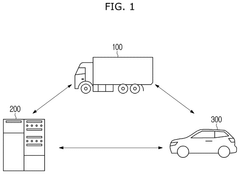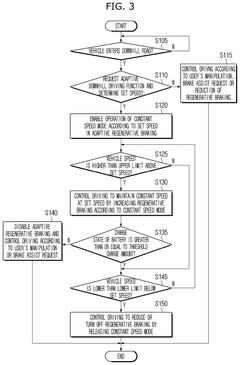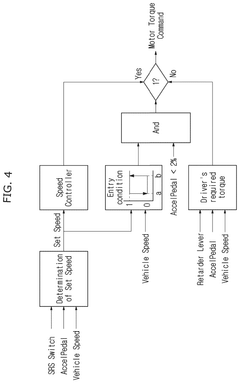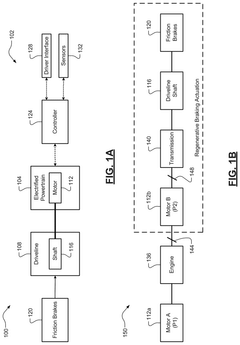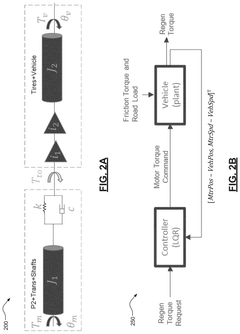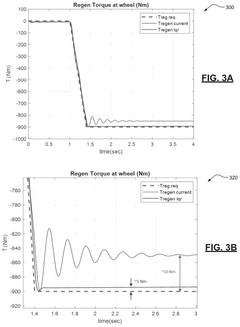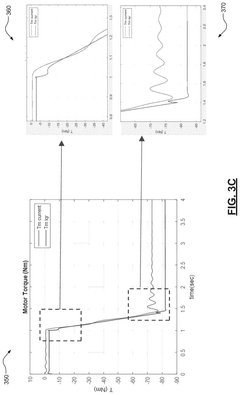The Role of Adaptive Control Systems in Regenerative Braking Technologies
AUG 15, 20259 MIN READ
Generate Your Research Report Instantly with AI Agent
Patsnap Eureka helps you evaluate technical feasibility & market potential.
Adaptive Control in Regenerative Braking: Background and Objectives
Regenerative braking technology has emerged as a crucial innovation in the automotive industry, particularly in the context of electric and hybrid vehicles. This technology harnesses the kinetic energy typically lost during braking and converts it into electrical energy, which can be stored and reused to power the vehicle. The evolution of regenerative braking systems has been closely tied to the advancement of electric vehicle technology, with significant developments occurring over the past few decades.
The primary objective of incorporating adaptive control systems into regenerative braking technologies is to optimize energy recovery while maintaining vehicle stability and driver comfort. Adaptive control systems can dynamically adjust the regenerative braking force based on various factors such as vehicle speed, road conditions, and driver input. This adaptability is crucial for maximizing energy efficiency and ensuring seamless integration with conventional friction braking systems.
The development of regenerative braking technology can be traced back to the early 20th century, with its first practical applications in electric trains. However, it wasn't until the late 1990s and early 2000s that regenerative braking began to gain traction in the automotive sector, coinciding with the rise of hybrid and electric vehicles. The Toyota Prius, introduced in 1997, was one of the first mass-produced vehicles to feature regenerative braking, marking a significant milestone in the technology's adoption.
As the automotive industry continues to shift towards electrification, the role of adaptive control in regenerative braking has become increasingly important. The technology aims to address several key challenges, including optimizing energy recovery across various driving conditions, ensuring smooth transitions between regenerative and friction braking, and maintaining vehicle stability during braking events.
The ongoing technological evolution in this field is driven by the need for more efficient and environmentally friendly transportation solutions. Adaptive control systems in regenerative braking are expected to play a crucial role in achieving higher energy efficiency, extended driving range for electric vehicles, and reduced wear on conventional braking components. Furthermore, as autonomous driving technologies advance, the integration of adaptive regenerative braking with vehicle-to-vehicle (V2V) and vehicle-to-infrastructure (V2I) communication systems presents new opportunities for optimizing energy recovery in complex traffic scenarios.
The primary objective of incorporating adaptive control systems into regenerative braking technologies is to optimize energy recovery while maintaining vehicle stability and driver comfort. Adaptive control systems can dynamically adjust the regenerative braking force based on various factors such as vehicle speed, road conditions, and driver input. This adaptability is crucial for maximizing energy efficiency and ensuring seamless integration with conventional friction braking systems.
The development of regenerative braking technology can be traced back to the early 20th century, with its first practical applications in electric trains. However, it wasn't until the late 1990s and early 2000s that regenerative braking began to gain traction in the automotive sector, coinciding with the rise of hybrid and electric vehicles. The Toyota Prius, introduced in 1997, was one of the first mass-produced vehicles to feature regenerative braking, marking a significant milestone in the technology's adoption.
As the automotive industry continues to shift towards electrification, the role of adaptive control in regenerative braking has become increasingly important. The technology aims to address several key challenges, including optimizing energy recovery across various driving conditions, ensuring smooth transitions between regenerative and friction braking, and maintaining vehicle stability during braking events.
The ongoing technological evolution in this field is driven by the need for more efficient and environmentally friendly transportation solutions. Adaptive control systems in regenerative braking are expected to play a crucial role in achieving higher energy efficiency, extended driving range for electric vehicles, and reduced wear on conventional braking components. Furthermore, as autonomous driving technologies advance, the integration of adaptive regenerative braking with vehicle-to-vehicle (V2V) and vehicle-to-infrastructure (V2I) communication systems presents new opportunities for optimizing energy recovery in complex traffic scenarios.
Market Analysis for Regenerative Braking Systems
The regenerative braking systems market has experienced significant growth in recent years, driven by increasing demand for energy-efficient vehicles and stringent environmental regulations. This market segment is closely tied to the electric and hybrid vehicle industry, which has seen exponential growth globally. As automotive manufacturers strive to meet fuel efficiency standards and reduce emissions, regenerative braking technology has become a crucial component in their vehicle designs.
The market for regenerative braking systems is segmented based on vehicle type, including passenger cars, commercial vehicles, and two-wheelers. Passenger cars currently dominate the market share, with electric and hybrid vehicles leading the adoption of this technology. However, the commercial vehicle segment is expected to witness the highest growth rate in the coming years, as fleet operators seek to reduce operational costs and comply with emissions regulations.
Geographically, the market is divided into North America, Europe, Asia-Pacific, and the rest of the world. Asia-Pacific, particularly China and Japan, holds the largest market share due to the high adoption rate of electric vehicles and government incentives promoting clean energy technologies. North America and Europe follow closely, with increasing investments in electric vehicle infrastructure and stringent emissions standards driving market growth.
The regenerative braking systems market is characterized by intense competition among key players, including major automotive manufacturers and specialized technology providers. These companies are continuously investing in research and development to improve the efficiency and performance of regenerative braking systems, with a focus on enhancing energy recovery rates and reducing system costs.
Market trends indicate a growing interest in advanced regenerative braking technologies, such as those incorporating adaptive control systems. These systems offer improved energy recovery efficiency by dynamically adjusting braking force based on various factors, including vehicle speed, road conditions, and driver behavior. The integration of artificial intelligence and machine learning algorithms in regenerative braking control systems is expected to further enhance their performance and adaptability.
The market outlook for regenerative braking systems remains positive, with projections indicating sustained growth over the next decade. Factors contributing to this growth include increasing environmental awareness, government regulations promoting clean energy technologies, and advancements in electric vehicle battery technology. As the automotive industry continues its shift towards electrification, the demand for more efficient and sophisticated regenerative braking systems is expected to rise, creating opportunities for innovation and market expansion.
The market for regenerative braking systems is segmented based on vehicle type, including passenger cars, commercial vehicles, and two-wheelers. Passenger cars currently dominate the market share, with electric and hybrid vehicles leading the adoption of this technology. However, the commercial vehicle segment is expected to witness the highest growth rate in the coming years, as fleet operators seek to reduce operational costs and comply with emissions regulations.
Geographically, the market is divided into North America, Europe, Asia-Pacific, and the rest of the world. Asia-Pacific, particularly China and Japan, holds the largest market share due to the high adoption rate of electric vehicles and government incentives promoting clean energy technologies. North America and Europe follow closely, with increasing investments in electric vehicle infrastructure and stringent emissions standards driving market growth.
The regenerative braking systems market is characterized by intense competition among key players, including major automotive manufacturers and specialized technology providers. These companies are continuously investing in research and development to improve the efficiency and performance of regenerative braking systems, with a focus on enhancing energy recovery rates and reducing system costs.
Market trends indicate a growing interest in advanced regenerative braking technologies, such as those incorporating adaptive control systems. These systems offer improved energy recovery efficiency by dynamically adjusting braking force based on various factors, including vehicle speed, road conditions, and driver behavior. The integration of artificial intelligence and machine learning algorithms in regenerative braking control systems is expected to further enhance their performance and adaptability.
The market outlook for regenerative braking systems remains positive, with projections indicating sustained growth over the next decade. Factors contributing to this growth include increasing environmental awareness, government regulations promoting clean energy technologies, and advancements in electric vehicle battery technology. As the automotive industry continues its shift towards electrification, the demand for more efficient and sophisticated regenerative braking systems is expected to rise, creating opportunities for innovation and market expansion.
Current Challenges in Adaptive Control for Regenerative Braking
Adaptive control systems in regenerative braking technologies face several significant challenges that hinder their widespread adoption and optimal performance. One of the primary obstacles is the inherent nonlinearity and time-varying nature of the braking system. The dynamics of the vehicle, road conditions, and brake system components constantly change, making it difficult for traditional control algorithms to maintain consistent performance across various scenarios.
Another major challenge lies in the accurate estimation of vehicle states and parameters. Regenerative braking efficiency heavily relies on precise knowledge of vehicle speed, wheel slip, and battery state of charge. However, obtaining these measurements in real-time with high accuracy remains problematic, especially in adverse weather conditions or on low-friction surfaces.
The integration of regenerative braking with conventional friction braking systems presents a complex control problem. Balancing the distribution of braking force between regenerative and friction brakes while ensuring smooth transitions and maintaining vehicle stability is a delicate task. This challenge is further compounded by the need to adapt to different driving styles and driver preferences.
Energy management optimization poses another significant hurdle. Adaptive control systems must continuously adjust their strategies to maximize energy recovery while considering factors such as battery temperature, state of charge, and power electronics limitations. Achieving this balance in real-time across various driving conditions and vehicle configurations is computationally intensive and requires sophisticated algorithms.
The variability in vehicle mass and load distribution also complicates the control task. As the vehicle's weight changes due to passengers or cargo, the optimal braking strategy must be adjusted accordingly. Developing adaptive systems that can quickly and accurately respond to these changes without compromising safety or efficiency remains a challenge.
Furthermore, the robustness of adaptive control systems in the presence of sensor noise and failures is a critical concern. Ensuring reliable operation and fail-safe mechanisms in the event of sensor malfunction or communication errors is essential for the safety and effectiveness of regenerative braking systems.
Lastly, the computational complexity and real-time implementation of advanced adaptive control algorithms present practical challenges. Balancing the need for sophisticated control strategies with the limitations of onboard computing resources and the requirement for fast response times is an ongoing area of research and development in the field of regenerative braking technologies.
Another major challenge lies in the accurate estimation of vehicle states and parameters. Regenerative braking efficiency heavily relies on precise knowledge of vehicle speed, wheel slip, and battery state of charge. However, obtaining these measurements in real-time with high accuracy remains problematic, especially in adverse weather conditions or on low-friction surfaces.
The integration of regenerative braking with conventional friction braking systems presents a complex control problem. Balancing the distribution of braking force between regenerative and friction brakes while ensuring smooth transitions and maintaining vehicle stability is a delicate task. This challenge is further compounded by the need to adapt to different driving styles and driver preferences.
Energy management optimization poses another significant hurdle. Adaptive control systems must continuously adjust their strategies to maximize energy recovery while considering factors such as battery temperature, state of charge, and power electronics limitations. Achieving this balance in real-time across various driving conditions and vehicle configurations is computationally intensive and requires sophisticated algorithms.
The variability in vehicle mass and load distribution also complicates the control task. As the vehicle's weight changes due to passengers or cargo, the optimal braking strategy must be adjusted accordingly. Developing adaptive systems that can quickly and accurately respond to these changes without compromising safety or efficiency remains a challenge.
Furthermore, the robustness of adaptive control systems in the presence of sensor noise and failures is a critical concern. Ensuring reliable operation and fail-safe mechanisms in the event of sensor malfunction or communication errors is essential for the safety and effectiveness of regenerative braking systems.
Lastly, the computational complexity and real-time implementation of advanced adaptive control algorithms present practical challenges. Balancing the need for sophisticated control strategies with the limitations of onboard computing resources and the requirement for fast response times is an ongoing area of research and development in the field of regenerative braking technologies.
Existing Adaptive Control Solutions for Regenerative Braking
01 Adaptive braking control systems
These systems adjust braking force based on real-time conditions, improving overall braking efficiency. They use sensors to monitor vehicle speed, wheel slip, and road conditions, then dynamically modify brake pressure to optimize stopping performance and maintain vehicle stability.- Adaptive braking control systems: These systems adjust braking force based on real-time conditions, improving overall braking efficiency. They use sensors to monitor vehicle speed, wheel slip, and road conditions, then dynamically modify brake pressure to optimize stopping performance and maintain vehicle stability.
- Anti-lock braking systems (ABS): ABS prevents wheel lock-up during heavy braking, maintaining steering control and reducing stopping distances on most surfaces. These systems rapidly modulate brake pressure to keep wheels rotating, allowing the driver to maintain directional control while maximizing braking efficiency.
- Electronic brake force distribution: This technology automatically varies the amount of force applied to each wheel's brake based on driving conditions and vehicle load. It ensures optimal brake force distribution between front and rear axles, enhancing stability and reducing stopping distances for improved overall braking efficiency.
- Regenerative braking systems: Primarily used in electric and hybrid vehicles, these systems convert kinetic energy during deceleration into electrical energy, which is then stored in the battery. This not only increases energy efficiency but also reduces wear on conventional friction brakes, thereby improving overall braking performance and longevity.
- Brake-by-wire systems: These advanced systems replace traditional hydraulic connections with electronic controls, allowing for more precise and rapid brake actuation. They can integrate with other vehicle systems to provide enhanced braking performance, improved pedal feel, and increased overall system efficiency.
02 Anti-lock braking systems (ABS)
ABS prevents wheel lock-up during heavy braking, maintaining steering control and reducing stopping distances on most surfaces. It rapidly modulates brake pressure to keep wheels rotating, allowing the driver to maintain directional control while maximizing braking efficiency.Expand Specific Solutions03 Electronic brake force distribution
This technology automatically varies the amount of force applied to each wheel's brake based on driving conditions and vehicle load. It ensures optimal brake force distribution between front and rear axles, enhancing stability and reducing stopping distances for improved overall braking efficiency.Expand Specific Solutions04 Regenerative braking systems
Primarily used in electric and hybrid vehicles, these systems convert kinetic energy during deceleration into electrical energy, which is then stored in the battery. This not only increases energy efficiency but also reduces wear on conventional friction brakes, thereby improving overall braking performance and longevity.Expand Specific Solutions05 Predictive braking systems
These advanced systems use sensors, cameras, and sometimes GPS data to anticipate braking needs before the driver applies the brakes. By pre-charging the brake system or automatically applying gentle brake pressure, they can significantly reduce reaction times and improve overall braking efficiency, especially in emergency situations.Expand Specific Solutions
Key Players in Adaptive Control and Regenerative Braking
The adaptive control systems in regenerative braking technologies market is in a growth phase, driven by increasing demand for electric and hybrid vehicles. The market size is expanding rapidly, with major automotive manufacturers and suppliers investing heavily in this technology. The technical maturity varies among players, with companies like Robert Bosch GmbH, Toyota Motor Corp., and Hyundai Motor Co. leading in innovation and implementation. Other key players such as ZF Active Safety GmbH, Nissan Motor Co., and Honda Motor Co. are also making significant advancements. The competitive landscape is characterized by ongoing research and development efforts to improve efficiency, reliability, and integration of these systems into various vehicle types.
Robert Bosch GmbH
Technical Solution: Bosch has developed an advanced adaptive control system for regenerative braking that dynamically adjusts the braking force distribution between regenerative and friction brakes. Their system utilizes a sophisticated algorithm that considers multiple factors such as vehicle speed, battery state of charge, and road conditions to optimize energy recovery while maintaining vehicle stability[1]. The system incorporates a predictive element that anticipates upcoming braking events based on GPS data and traffic information, allowing for more efficient energy capture[3]. Bosch's technology also features a seamless blending of regenerative and friction braking, ensuring a smooth and consistent pedal feel for the driver[5]. Additionally, their system includes a self-learning component that adapts to individual driving styles over time, further enhancing efficiency and user experience[7].
Strengths: High efficiency in energy recovery, seamless integration of regenerative and friction braking, adaptive to various driving conditions. Weaknesses: Complexity may lead to higher costs, potential over-reliance on electronic systems.
GM Global Technology Operations LLC
Technical Solution: GM has developed a cutting-edge adaptive control system for regenerative braking that utilizes a multi-modal approach. Their system incorporates data from various vehicle sensors, including wheel speed sensors, accelerometers, and even camera systems, to create a comprehensive understanding of the vehicle's dynamic state[1]. This allows for precise modulation of regenerative braking force in real-time. GM's technology also features a unique "cooperative regenerative braking" system that intelligently balances the use of regenerative and friction brakes to maximize energy recovery while maintaining optimal brake pad life[3]. Additionally, their system includes an advanced thermal management component that monitors brake system temperatures and adjusts regenerative braking usage to prevent overheating in extreme conditions[5]. GM has also integrated their regenerative braking system with their proprietary electronic stability control system, enhancing both energy recovery and vehicle handling in challenging driving situations[7].
Strengths: Comprehensive sensor integration, balanced approach to brake system longevity, advanced thermal management. Weaknesses: Potential for increased system complexity, may require more frequent calibration.
Core Innovations in Adaptive Control Systems
Method and vehicle for driving control using adaptive regenerative braking
PatentPendingUS20250196660A1
Innovation
- A method and vehicle system utilizing adaptive regenerative braking, which adjusts braking control based on slope conditions by implementing a constant speed mode during downhill driving, ensuring optimal vehicle speed convergence and efficient battery charging.
Regenerative braking control for improved drivability on electrified propulsion systems
PatentPendingUS20250074200A1
Innovation
- A control system that includes sensors to measure braking torque requests and driveline parameters, and a controller that uses a linear-quadratic regulator (LQR) with integral action to model driveline dynamics, adjust motor torque commands, and control regenerative braking to improve performance and drivability.
Energy Efficiency and Environmental Impact
Regenerative braking technologies, enhanced by adaptive control systems, play a crucial role in improving energy efficiency and reducing environmental impact in modern transportation systems. These advanced braking systems recover kinetic energy that would otherwise be lost as heat during conventional braking, converting it into electrical energy for reuse. This process significantly enhances the overall energy efficiency of vehicles, particularly in electric and hybrid vehicles.
The implementation of adaptive control systems in regenerative braking technologies allows for optimized energy recovery across various driving conditions. These systems continuously adjust the regenerative braking force based on factors such as vehicle speed, road conditions, and driver behavior. By doing so, they maximize energy recuperation while maintaining vehicle stability and driver comfort. This adaptive approach ensures that energy recovery is optimized in diverse scenarios, from urban stop-and-go traffic to highway cruising.
The environmental impact of regenerative braking technologies is substantial. By reducing the reliance on friction braking, these systems minimize brake wear and the associated particulate emissions. This reduction in brake dust contributes to improved air quality, particularly in urban environments where vehicle emissions are a significant concern. Furthermore, the increased energy efficiency translates to reduced fuel consumption in hybrid vehicles and extended range in electric vehicles, leading to lower overall greenhouse gas emissions.
In electric vehicles, regenerative braking can recover up to 70% of the kinetic energy that would otherwise be lost. This recovered energy is used to recharge the vehicle's battery, extending its driving range and reducing the frequency of charging. For hybrid vehicles, the energy recovered through regenerative braking can be used to power the electric motor, reducing the load on the internal combustion engine and thereby decreasing fuel consumption and emissions.
The integration of adaptive control systems in regenerative braking also contributes to the development of more efficient and environmentally friendly transportation systems. These technologies are not limited to personal vehicles but are increasingly being adopted in public transportation, such as electric buses and trains. In these applications, the energy savings and reduced environmental impact are multiplied due to the higher frequency of stops and the larger scale of operations.
As cities worldwide strive to reduce their carbon footprint and improve air quality, the role of regenerative braking technologies with adaptive control systems becomes increasingly important. These systems represent a key component in the broader strategy of sustainable urban mobility, contributing to the goals of energy conservation and environmental protection in the transportation sector.
The implementation of adaptive control systems in regenerative braking technologies allows for optimized energy recovery across various driving conditions. These systems continuously adjust the regenerative braking force based on factors such as vehicle speed, road conditions, and driver behavior. By doing so, they maximize energy recuperation while maintaining vehicle stability and driver comfort. This adaptive approach ensures that energy recovery is optimized in diverse scenarios, from urban stop-and-go traffic to highway cruising.
The environmental impact of regenerative braking technologies is substantial. By reducing the reliance on friction braking, these systems minimize brake wear and the associated particulate emissions. This reduction in brake dust contributes to improved air quality, particularly in urban environments where vehicle emissions are a significant concern. Furthermore, the increased energy efficiency translates to reduced fuel consumption in hybrid vehicles and extended range in electric vehicles, leading to lower overall greenhouse gas emissions.
In electric vehicles, regenerative braking can recover up to 70% of the kinetic energy that would otherwise be lost. This recovered energy is used to recharge the vehicle's battery, extending its driving range and reducing the frequency of charging. For hybrid vehicles, the energy recovered through regenerative braking can be used to power the electric motor, reducing the load on the internal combustion engine and thereby decreasing fuel consumption and emissions.
The integration of adaptive control systems in regenerative braking also contributes to the development of more efficient and environmentally friendly transportation systems. These technologies are not limited to personal vehicles but are increasingly being adopted in public transportation, such as electric buses and trains. In these applications, the energy savings and reduced environmental impact are multiplied due to the higher frequency of stops and the larger scale of operations.
As cities worldwide strive to reduce their carbon footprint and improve air quality, the role of regenerative braking technologies with adaptive control systems becomes increasingly important. These systems represent a key component in the broader strategy of sustainable urban mobility, contributing to the goals of energy conservation and environmental protection in the transportation sector.
Safety and Reliability Considerations
Safety and reliability are paramount considerations in the development and implementation of adaptive control systems for regenerative braking technologies. These systems must operate flawlessly under diverse and often challenging conditions to ensure the safety of vehicle occupants and other road users.
One of the primary safety concerns is the potential for system failure or malfunction. Adaptive control systems must be designed with robust fail-safe mechanisms to prevent catastrophic failures that could compromise vehicle stability or braking performance. This includes implementing redundant sensors, actuators, and control units to maintain functionality even if one component fails.
The integration of regenerative braking with traditional friction braking systems presents unique challenges. The adaptive control system must seamlessly coordinate between these two braking methods to provide consistent and predictable deceleration. Any abrupt transitions or unexpected changes in braking force could lead to loss of vehicle control, especially in emergency situations or adverse weather conditions.
Reliability is crucial for maintaining public trust and widespread adoption of regenerative braking technologies. The adaptive control systems must demonstrate long-term durability and consistent performance across the vehicle's lifespan. This requires extensive testing under various environmental conditions, including extreme temperatures, humidity, and vibration.
Another critical aspect is the system's ability to adapt to changes in vehicle dynamics and road conditions. The control algorithms must be sophisticated enough to handle variations in vehicle load, tire grip, and road surface characteristics. Failure to account for these factors could result in suboptimal braking performance or, worse, compromised vehicle stability.
Cybersecurity is an emerging concern in modern vehicle systems. As adaptive control systems become more connected and reliant on external data inputs, they become potential targets for cyber attacks. Robust security measures must be implemented to protect against unauthorized access or manipulation of the braking system.
Regulatory compliance is also a key consideration. Adaptive control systems for regenerative braking must meet or exceed all relevant safety standards and regulations. This includes adherence to international standards such as ISO 26262 for functional safety of automotive electronic systems.
Lastly, the human factor must not be overlooked. The system's behavior should be intuitive and predictable to drivers, avoiding any sudden or unexpected changes in vehicle response that could startle or confuse the operator. Clear communication of system status and any potential issues to the driver is essential for maintaining situational awareness and overall safety.
One of the primary safety concerns is the potential for system failure or malfunction. Adaptive control systems must be designed with robust fail-safe mechanisms to prevent catastrophic failures that could compromise vehicle stability or braking performance. This includes implementing redundant sensors, actuators, and control units to maintain functionality even if one component fails.
The integration of regenerative braking with traditional friction braking systems presents unique challenges. The adaptive control system must seamlessly coordinate between these two braking methods to provide consistent and predictable deceleration. Any abrupt transitions or unexpected changes in braking force could lead to loss of vehicle control, especially in emergency situations or adverse weather conditions.
Reliability is crucial for maintaining public trust and widespread adoption of regenerative braking technologies. The adaptive control systems must demonstrate long-term durability and consistent performance across the vehicle's lifespan. This requires extensive testing under various environmental conditions, including extreme temperatures, humidity, and vibration.
Another critical aspect is the system's ability to adapt to changes in vehicle dynamics and road conditions. The control algorithms must be sophisticated enough to handle variations in vehicle load, tire grip, and road surface characteristics. Failure to account for these factors could result in suboptimal braking performance or, worse, compromised vehicle stability.
Cybersecurity is an emerging concern in modern vehicle systems. As adaptive control systems become more connected and reliant on external data inputs, they become potential targets for cyber attacks. Robust security measures must be implemented to protect against unauthorized access or manipulation of the braking system.
Regulatory compliance is also a key consideration. Adaptive control systems for regenerative braking must meet or exceed all relevant safety standards and regulations. This includes adherence to international standards such as ISO 26262 for functional safety of automotive electronic systems.
Lastly, the human factor must not be overlooked. The system's behavior should be intuitive and predictable to drivers, avoiding any sudden or unexpected changes in vehicle response that could startle or confuse the operator. Clear communication of system status and any potential issues to the driver is essential for maintaining situational awareness and overall safety.
Unlock deeper insights with Patsnap Eureka Quick Research — get a full tech report to explore trends and direct your research. Try now!
Generate Your Research Report Instantly with AI Agent
Supercharge your innovation with Patsnap Eureka AI Agent Platform!
